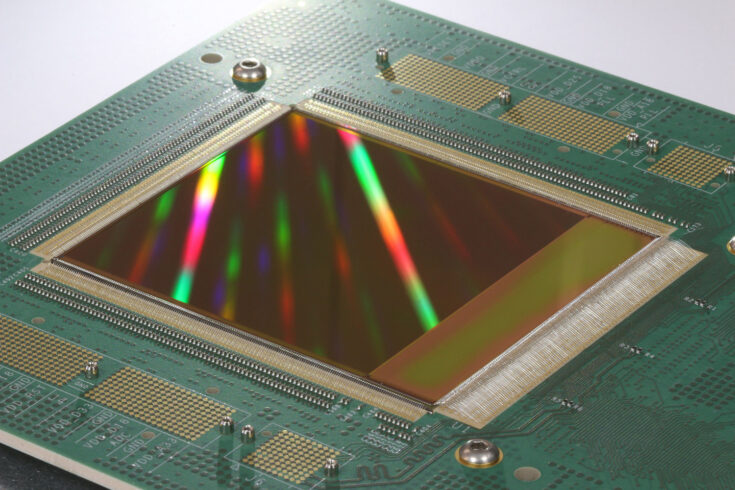A new generation of detector, based on technology developed by UK Research and Innovation, is set to transform the field of electron cryo-microscopy.
The new detector is being brought to market by Quantum Detectors. It is developed by the Science and Technology Facilities Council (STFC) in partnership with the Rosalind Franklin Institute and MRC Laboratory of Molecular Biology (MRC LMB).
Electron cryo-microscopy (cryoEM), uses precision high energy beams of electrons rather than visible light to study the structure of biological samples at cryogenic temperatures to achieve imaging at the atomic level.
The innovative detector technology developed by STFC’s Technology department will eventually lead to cryoEM techniques becoming available to non-specialist laboratories while specialist laboratories can undertake more complex work. This will raise the standards of research across the board.
Low energy cryoEM
Until now, the leading industry standard cryoEM systems have all required huge amounts of power. The standard systems operate with 300keV electron sources and are complex, specialised machines that are only available in specialist microscopy centres.
Recently, pioneering scientists demonstrated (Rosalind Franklin Institute) that similar imaging resolutions could be achieved with electrons at a much lower energy of 100keV.
The new commercial venture with Quantum Detectors aims to provide a detector which can aid in radically simplifying the microscope design.
This will ultimately make the technique much more accessible and widely-used across science and industry.
Collaboration between science and industry
Dr Barbara Ghinelli, STFC’s Director of Campus Development and Clusters and a Rosalind Franklin board member, said:
This is an excellent example of how the research base and industry can come together to develop and commercialise world-leading technology that will benefit society.
STFC’s Technology department developed the detector in consultation with cryoEM pioneer and Nobel Prize winner, Dr Richard Henderson and MRC LMB group leader Dr Chris Russo.
Dr Hazel Housden, the Rosalind Franklin Institute’s Innovation and Translation Manager, said:
This is an exciting step forward in the democratisation of the cryoEM technology. It will make the technique accessible to everyday laboratories, allowing many more researchers to obtain high resolution images of their own biological samples in-house, and free up specialist labs to undertake more complex research and development work.
We are looking forward to seeing the great discoveries that will come from this revolution.
Better access to imaging
The Quantum C100 detector, based on innovative work at STFC, has been optimised for 100 keV and has been developed as a key component to facilitate economic access of the emerging field of imaging around the world.
Roger Goldsbrough, CEO of Quantum Detectors, said:
We’ve been providing advanced detector solutions for almost 15 years now, and the introduction of the Quantum C100 will take product innovation to another level.
We are absolutely delighted to have been selected to partner with the Rosalind Franklin Institute and the STFC, to help bring CryoEM technology to a far wider scientific community, with a whole new class of instrumentation delivering the higher quality data that scientists need.
Further information
Quantum Detectors Ltd
Quantum Detectors (QD) is a market-leading provider of advanced direct electron detectors (DED) used in transmission electron microscopy (TEM).
Originally focused solely on the X-ray community, QD expanded into serving the microscopy community. They are now at the forefront of 4D scanning transmission electron microscope analysis, with the largest installed base of counting DEDs supporting all major TEM brands. These include:
- Hitachi
- JEOL
- Thermo Fisher Scientific.
The company has a reputation for customer service and support, offering lifetime product care, continuous product improvement and bespoke solutions. Further information can be found at: Quantum Detectors.
The Rosalind Franklin Institute
The Rosalind Franklin Institute is a national institute dedicated to transforming life science through interdisciplinary research and technology development.
The institute brings together researchers in life, physical science, and engineering, to develop disruptive new technologies designed to tackle major challenges in health and life sciences.
Focussing initially on five major research themes, the institute aims to have a significant impact in imaging, diagnostics, drug development, and many more fields.
The Franklin is funded through the UK Research and Innovation through the Engineering and Physical Sciences Research Council.
The institute is an independent organisation founded by the UK Research and Innovation, ten UK universities, and Diamond Light Source, with its central hub at the Harwell Science and Innovation Campus.
The Rosalind Franklin Institute is a company limited by guarantee registered in England and Wales, registration number 11266143. We are a registered charity, number 1179810.
Twitter: @RosFrankInst

